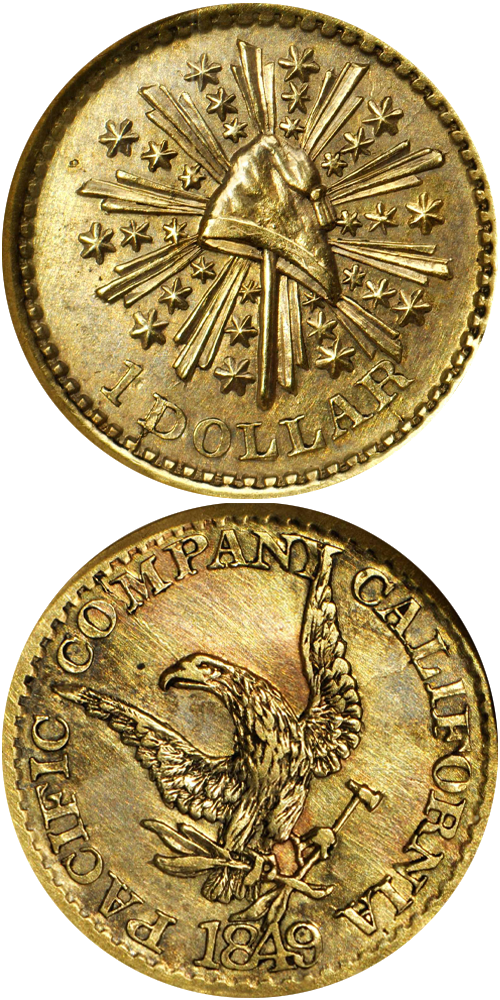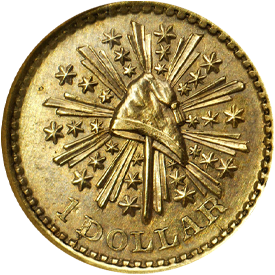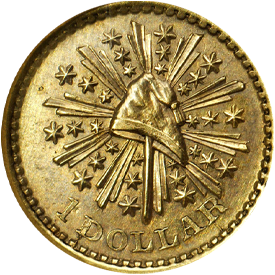As the California Gold Rush heated up, many enterprising companies struck out for the gold fields with the hopes of assaying the finds and producing locally accepted privately issued coins. While there are recorded a number of such proposed companies with "Pacific" in their names, it is widely accepted that the Pacific Company formed in Boston on January 8, 1849 by John W. Cartwright is the organization originally behind the Pacific Company coinage. Composed of 38 subscribers who contributed $1,000 each to join, the Pacific Company bought and outfitted the vessel York. As part of their equipment were sets of dies for a planned issue of $1, $2.50, $5, and $10 gold pieces. The four denominations all bear a version of the same design: on the obverse is a Liberty cap with stars and rays (closely resembling Mexican silver coins of the period) with the denomination indicated below and on the reverse is a heraldic eagle clutching an olive branch and hammer surrounded by the legend, PACIFIC COMPANY, CALIFORNIA. and the date 1849. The York sailed out of Boston Harbor on April 1, 1849 and arrived in San Francisco Bay on September 16. One of the company members presciently observed in his diary: "All that board us say that our company will break up as all others have done." That is indeed what happened not long after the party arrived at their destination of Benicia on October 8. Scarcely twelve days later the Pacific Company was officially dissolved and its members went their separate ways without having ever striking a single gold coin.
Based on a thorough analysis of surviving Pacific Company coins, the dies apparently came into the possession of the well-established assay company of Broderick & Kohler in San Francisco soon after the original company's dissolution. Col. Jonathan D. Stevenson, a former commander of a regiment of New York Volunteers and a veteran of the Mexican War found early success in the Gold Rush. He brought in fellow New Yorkers Frederick D. Kohler and David C. Broderick to begin an assay and refining firm that soon branched out into coining using the Pacific Company dies. Broderick & Kohler opted to use the dies with no modification to produce their own coinage, primarily consisting of $5 and $10 pieces. Unlike most private coiners, Broderick & Kohler did not use a screw press but instead produced their coins using a sledgehammer. When the coins were first introduced into daily commerce, the coins were accepted at par initially under the premise that anything was better than using raw gold dust and placer gold. Like many other of the earliest private coiners during the Gold Rush, the coin's purity was inconsistent at best, mostly based on the fineness of the metal as originally mined without much further refinement. While some coiners tried to compensate for this by making their coins heavier, the Pacific Company coins were not, earning the business a decent return on investment while short-changing the public who used the coins. This business model fared well for both Broderick and Kohler because of the high profit margin and, combined with successful real estate investments, they soon were able to shutter their assay and coining business. Broderick was elected as state senator in January of 1850 and left the partnership, while Kohler carried on for only a couple of months before shuttering the business and selling off all the firm's equipment in its entirety in March to Baldwin & Co., long before the comparatively low purity of their product was discovered. When examples of the $5 and $10 coins were assayed by the Mint in 1851, they were found to have an intrinsic value of $4.48 and an astonishingly low $7.76, respectively, among the lowest of the private issuers at the time. Once news of the poor assays reached California, the coins were promptly rejected as sub-par and quickly found themselves in melting pots within just a few years, accounting for the tremendous rarity of any Pacific Company issue today. Despite the assay results, Kohler and Broderick's reputations appear to have not been substantially impacted. Kohler became State Assayer the following month and continued on in local public service until his death in 1864. Broderick was eventually elected U.S. Senator for California in 1857, an office he held until he was killed in a duel in 1859.
While dies were produced for a $2.50 coin, no gold example has to date ever been found or recorded, just a precious few silver patterns. For decades, the gold dollar was also widely assumed to have been struck in gold for circulation. At least three silver pattern strikes are known, including a uniface obverse struck on a 1776 Spanish colonial 1 real coin and another overstruck on a half dime, as well as additional extremely rare specimens struck in white metal. Precisely who struck the off-metal patterns is not known; they could have been produced back East when the dies were prepared or by Broderick & Kohler to test their coining equipment. Wayte Raymond illustrated a holed example of the gold dollar (almost certainly the Granberg-Newcomer-Mehl-Williams-duPont specimen) in his 1931 work, Private Gold Coins Struck in the United States, 1830-1861, though with no commentary. Even in 1981's landmark Private Gold Coins and Patterns of the United States by Donald Kagin the $1 issue was listed as a pattern.
The $1 piece continued to be considered a pattern for many years until June of 1999 when a metal detector in New Bethlehem, Pennsylvania recovered a gold specimen. This coin was at one time mounted onto jewelry and retains the evidence of the solder used to mount the coin. As news of the confirmation that gold $1 coins exist, the issue once again attracted interest. The Granberg-Newcomer-Mehl-Williams-duPont piece illustrated by Raymond back in 1931 was also reassessed and though the coin itself cannot be examined, it is regarded to be a gold coin.








